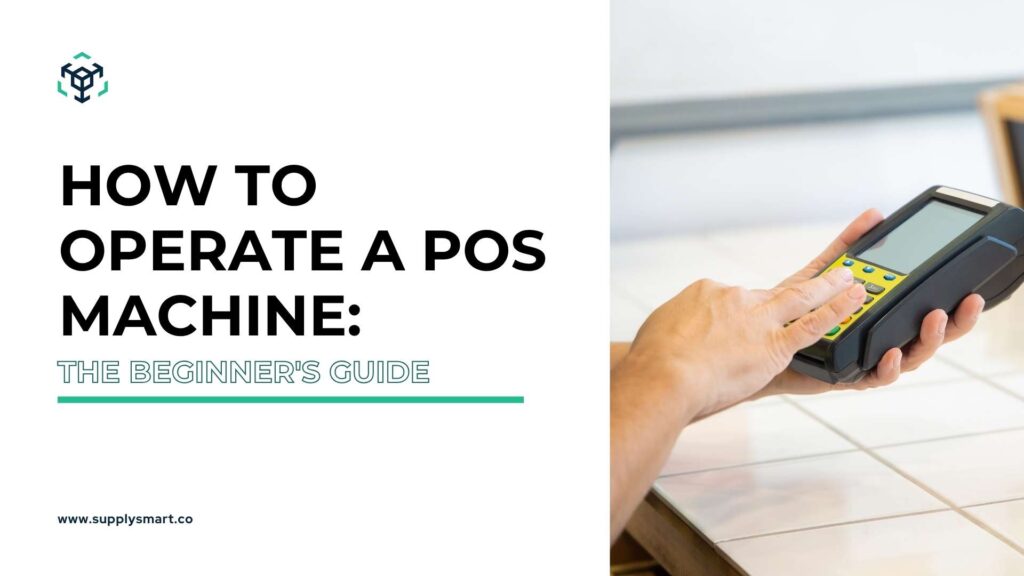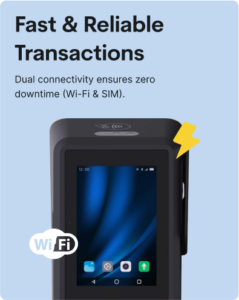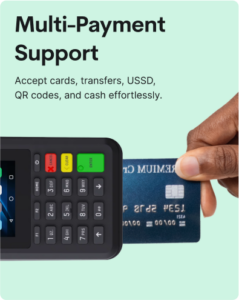Accepting various payment methods is very important now in this digital age, and if you’re just starting with digital payments or upgrading your system, POS machines might seem tricky.
You might be worried about mistakes or things going wrong. I mean, what if you make a mistake during a transaction? Or how can you avoid awkward moments with customers if something goes wrong? These concerns are valid, especially if you’re transitioning from familiar cash payments to a digital setup.
But don’t stress! Using a POS machine is easier than you think.
This guide will walk you through the steps and share tips to make you feel confident.
Getting Started with a POS Machine
Here’s how to quickly get going with a POS machine:
1. Know Your Machine:
All POS machines have a card reader, screen, keypad, and sometimes a receipt printer.
Take a few minutes to familiarize yourself with these parts. Countless studies have shown that businesses that learned POS basics had fewer mistakes.
2. Set It Up:
- Unpack the machine and ensure all components, power cords, card readers, and receipt rolls are included.
- Plug it in and connect to the internet using Wi-Fi or Ethernet.
- Install Necessary Software: Many modern POS systems require an app or software installation to sync with your business system. Check the user manual for detailed steps.
- Add your business name, currency, and tax information.
3. Do a Test Run:
Before facing your first customer, try a practice payment with each type of card (swipe, chip) to catch any problems and get confident.
4. Keep It Secure:
Ensure your POS system meets industry-standard security protocols:
- Use end-to-end encryption for all transactions.
- Regularly update your software to protect against vulnerabilities.
- Avoid using public Wi-Fi networks for POS transactions.
Step-by-Step Guide to Operating a POS Machine
1. Turn it on
First, make sure the POS machine is plugged in or charged. Press the power button until it turns on. If it’s a countertop machine, make sure it’s on the internet using Wi-Fi, a cable, or a phone connection.
You need a good internet connection to make sure things go smoothly – a lot of people will just leave if the payment system is slow or doesn’t work.
Speaking of a good internet, you might want to consider a reliable POS machine that gives unlimited data. This means to don’t have to worry about the cost of data.
You’re welcome.
2. Start the Payment
When someone is ready to pay:
- Type in the amount on the keypad or screen.
- Make sure the amount is right before you go on, especially when it’s busy.
3. Pick How to Pay
New POS machines can take different kinds of payments:
Chip Cards: Put the card in the reader and wait (The most common in Nigeria).
Swipe Cards: Swipe the card on the side.
Touchless Payments: Have the person tap their card, phone, or watch on the symbol.
They’re all a little bit different, but the screen will show you what to do.
4. PIN or Approval
When someone is paying with a debit card, they would need to enter their PIN. Give them the machine so they can enter it safely.
5. Check the Payment
After the payment goes through:
- The POS machine will say it worked, usually with a number for the payment.
- If it doesn’t work, it will ask you to try again or use another payment method. Be polite and explain what happened to the customer.
6. Give a Receipt
You can:
- Print a Receipt: Tear off the paper and give it to the customer.
Giving options for receipts is good for customers and good for the environment.
7. Finish Up
Thank the customer, give them back their card, and make sure they have their receipt. Being polite can make them trust you and want to come back.
8. Fix Problems
Sometimes things go wrong, like the machine freezing or not taking a good card. Don’t worry, try this:
- Restart the Machine: Turn it off and on.
- See if the Internet is Working: Make sure the Wi-Fi or mobile hotspot is connected.
- Call for Help: If it still doesn’t work, call the company that gave you the POS machine.
Most people will judge a business by how easy it is to pay. If you fix problems fast, it can make a bad situation better.
Tips as a First-Time User
1. Practice First: Get to know the machine before your first customer. Use demo modes or sample transactions to copy real situations. Most people make fewer mistakes after practising.
2. Stay Organized: Keep your POS area tidy. Have spare receipt paper and chargers nearby. This helps things go smoothly and looks pro.
3. Talk Clearly: Be clear with customers. Tell them where to insert their card or enter their PIN. Good talks avoid confusion.
4. Check Amounts: Always double-check the amount before you charge someone. It prevents problems and builds trust.
5. Be Patient: Mistakes happen! If something goes wrong, take a breath and follow the machine’s instructions. If you’re stuck, check the manual or call support.
6. Anticipate Problems: Be ready for common issues.
Declined Cards: Politely ask for another card.
Connection Issues: Check your network. Use a mobile hotspot as a backup.
Slow Machine: Restart it or check for updates.
Conclusion
Using a POS machine doesn’t have to be hard. If you learn how it works and practice, it’ll become easy.
When you first start, it’s fine to make mistakes. Most small business owners who learn their POS systems say their work gets done better in a few months. So, stick with it.
As you use your POS machine more, it will make transactions simpler. It also helps keep track of things and makes customers happier.
So, take the time to learn it. Each sale is an opportunity to show that you’re reliable and professional. As you get better, running your business will get easier.




